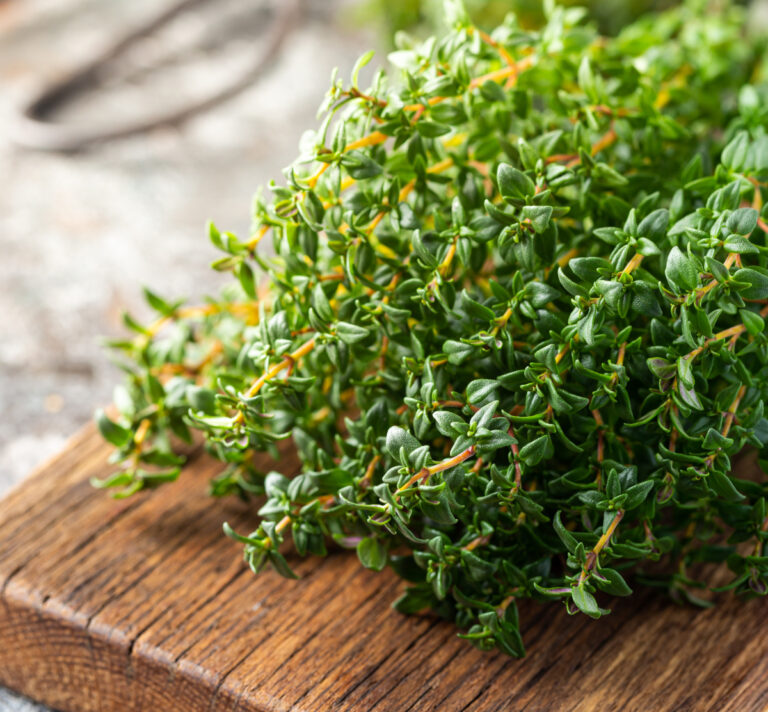Health Benefits of Goldenrod: For Inflammation, Allergies, and More
Do you suffer from seasonal allergies? If you do, check out the health benefits of goldenrod that may just be what you need to quit sneezing and enjoy the season!
Pin it for later ⤵️
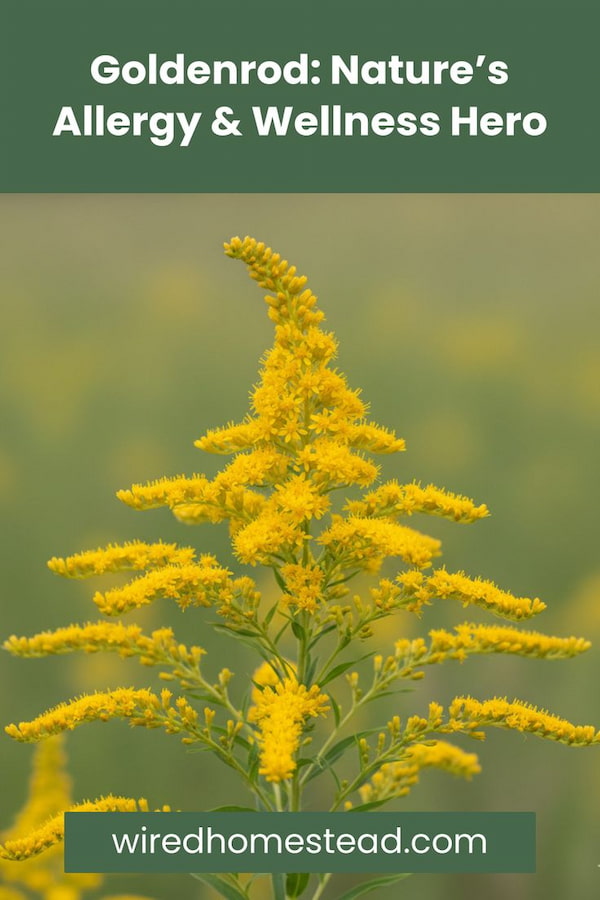
How to Identify Goldenrod
Goldenrod (Solidago) is a beautiful plant with small clusters of yellow flowers that branch out at the tip of the plant. It has thin, alternating leaves that grow up the stem. The plant generally grows around 3 feet or so tall.
You can often find this plant in meadows, plains, pastures, and along stream banks. It spreads easily, so when you find one you often find quite a few more close by! There are many types of goldenrod, but this post will be focusing on Solidago canadensis, or Canada goldenrod.
Canada goldenrod is native across Canada and the United States. I’m writing specifically about this species of goldenrod because it is native to my geographic region in the Pacific Northwest of the U.S. The most powerful herbs for you are the ones located in your geographical area. You are biologically wired to react better to native plants than other types. That doesn’t mean I don’t use non-native medicinal plants, but the more local you get, the better reaction to them you are likely to have.
There are many health benefits of goldenrod. You may decide that it deserves a place in your apothecary, especially if you are an allergy sufferer.
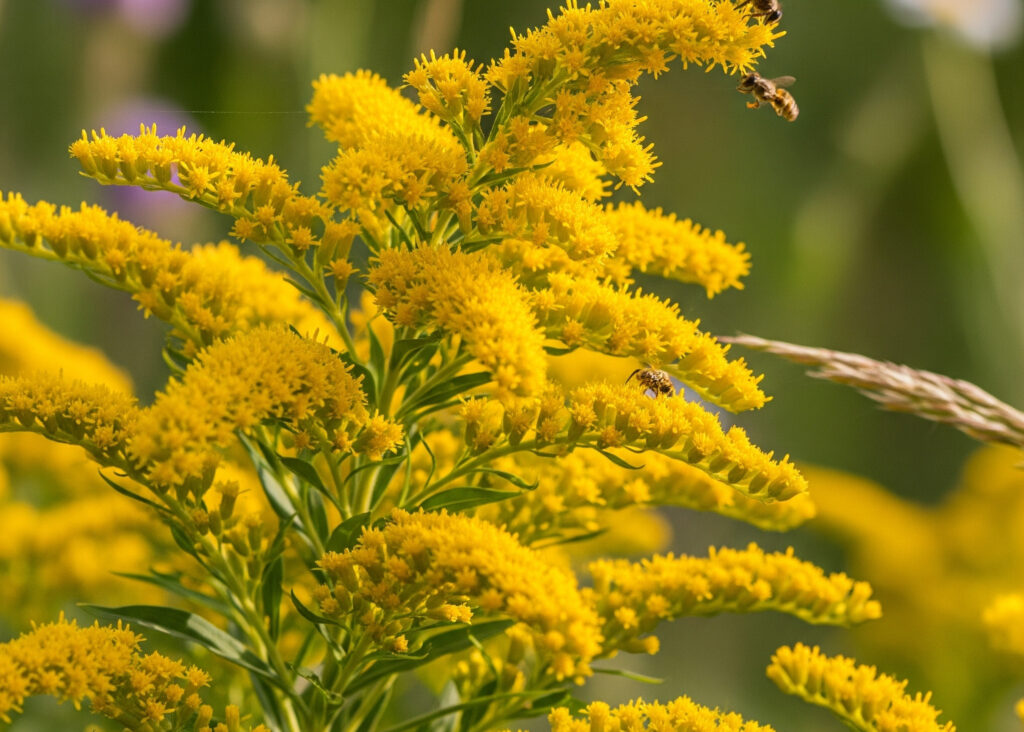
Health Benefits of Canada Goldenrod
*I am not a doctor nor is this medical advice. Please consult your doctor before starting any medicinal herbs
Allergies and Inflammation
So many of us suffer from allergies these days. Lots of people are allergic to very specific things, others have more generalized allergies. Hayfever, or an allergic reaction to airborne particles such as pollen or dust mites, is one of the more generalized and widely common allergies. If you have hayfever, you know how miserable it can be!
Insert goldenrod here. Goldenrod is great at suppressing the coughs and sneezes that accompany hayfever and other seasonal allergies. It smooths out the airways and calms that cough down. Because it also has anti-inflammatory properties, it can also help reduce the inflammation often seen with allergy symptoms.
Goldenrod is often mistaken to be a source of allergens, but often ragweed is the responsible party. They bloom at the same time. Ragweed brings on allergies while goldenrod helps calm them down.
Aside from just inflammation from allergies, goldenrod is considered an antiphlogistic. That’s the fancy term meaning it can reduce inflammation in general. When used as a mouth rinse, it can help with mouth and throat inflammation.
Infections and Burns
Plants must develop natural mechanisms for fighting pests and diseases. The compounds plants make to keep themselves healthy often extend their benefits to us as well.
Goldenrod is:
- Antimicrobial
- Antibacterial
- Antiviral
- Stypic – can help stop bleeding by promoting blood clotting
Goldenrod has been found to be effective in treating infected wounds that have pus discharge.
Making a poultice out of the root can help prevent infection and heal burns.
Boils and gum abscess issues are also no match for goldenrod. A poultice or compress is the perfect way to treat these conditions, along with infected wounds with pus and burns. Apply the poultice or compress directly to the wound to get the medicinal qualities of the plant directly where they are needed.
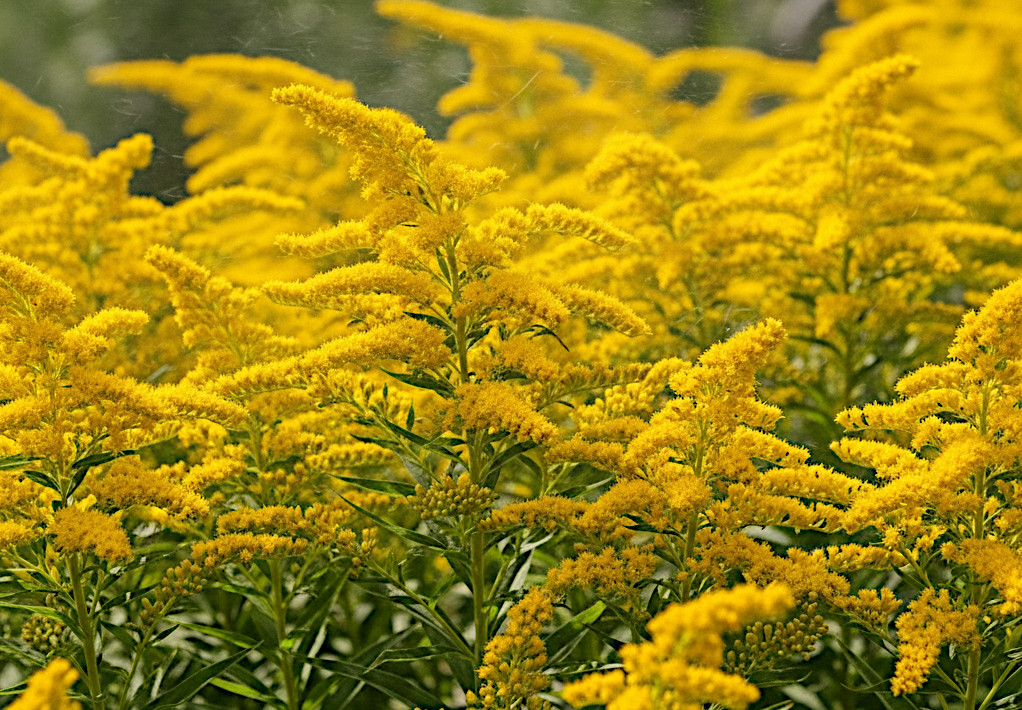
Health Benefits of Goldenrod for the Kidneys and Urinary Tract
We’ve talked about the anti-inflammatory properties of goldenrod already, but I want to give it a shout out specifically for the kidneys and urinary tract. Studies show that this plant has been effective in treating cystitis (inflammation of the bladder due to infection) and chronic kidney inflammation (nephritis).
It has also been shown to be effective in treating urolithiasis. We generally think of this as kidney stones, but urolithiasis refers to the stones in general. They may be located in the kidneys or may have moved down into the urethra.
Staying with the theme of inflammation, goldenrod has promise in treating prostate swelling called prostatitis and possibly prostrate adenoma as well.
The Big C – How Goldenrod May Help Fight Cancer and Help With Chemotherapy
Multiple studies have shown Goldenrod has anticarcinogenic properties. Let’s look a little deeper at what that looks like for this plant.
Cancer is characterized by the mutation in a cell that results in unchecked, creating tumors in the body. Goldenrod has been found to be antimutagenic and antitumor. This means that goldenrod can help potentially prevent the mutation of the cell to begin with.
If the mutation happens and the cell begins to rapidly replicate, studies have shown that goldenrod can help inhibit cancer initiation, halt progression, and stop the cells from spreading to new locations in the body. This can lead to stopping the mutated cell cycle and the death of the unhealthy cells.
Hopefully new studies will continue to show promise for goldenrod as a treatment for cancer.
Chemotherapy is widely used treatment for cancer but has side effects for those who are being treated. Goldenrod has chemoprotective properties and can help reduce oxidative stress caused by chemo. Oxidative stress can cause the inability of antioxidants in your body to correctly react to stresses that can cause degradation of cells.
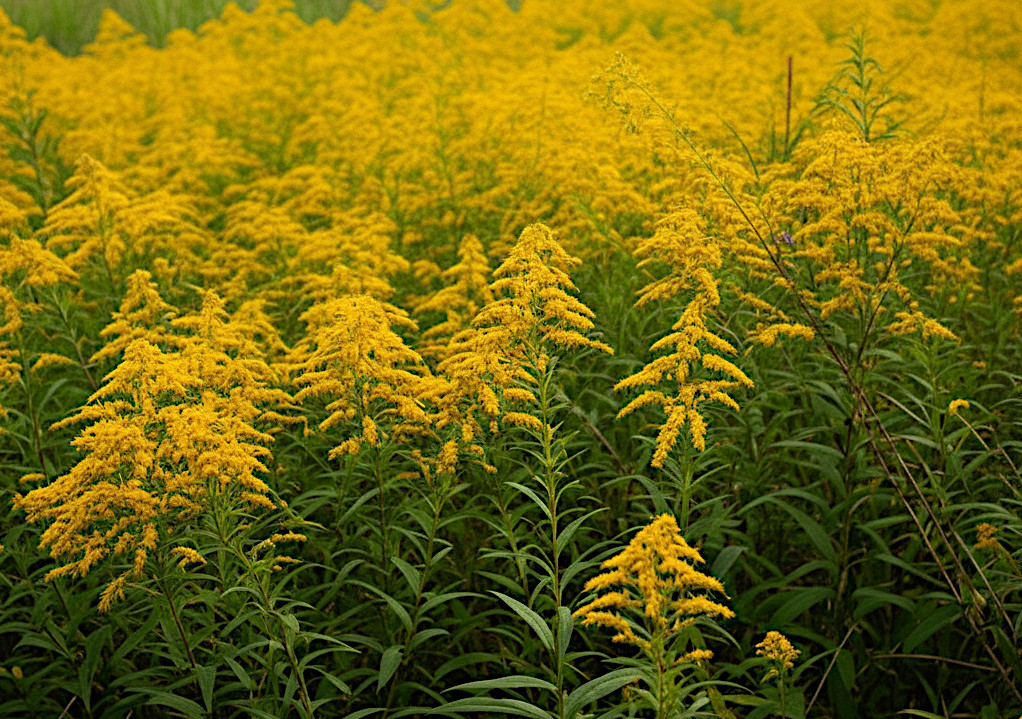
How You Can Unlock the Health Benefits of Goldenrod
There are several ways you can use goldenrod as medicine:
- Make a tea
- Use as a poultice
- Use it as a tincture
- Infuse it in oil
Make a Tea
To make a tea with goldenrod, take about a tablespoon of dried plant matter and infuse it into about 8 oz of hot water. You can buy reusable tea bags or use tea infusers. I prefer the tea infusers as I find them easier to clean than tea bags.
Once you place the plant matter in the cup, cover the cup with a lid, plate, or something else so the steam does not escape. The steam contains essential oils and medicinal properties, you don’t want to lose them to the air!
Let steep for about 10-15 minutes and enjoy your tea!
Making a Poultice
You can prepare the plant material in a couple of different ways for a poultice. Prepare it as a tea as described above, then soak a piece of material in the tea. A piece of cotton or muslin material works great, but anything that will soak up the liquid will be fine.
You can also make a decoction, which is like a tea. Take 1 oz of dried plant material per quart of boiling water. Pour the boiling water over the plant material, place a lid on, and let it cool completely. This is a great extraction method, you can also drink a decoction just like a tea. Once prepared, use a piece of material to soak up the infused water.
For teas and decoctions, place the soaked material straight onto the wound or other place you would like the medicine from the plant to be absorbed.
The third option is to use the plant material straight out of the ground. Crush it up to release the juices of the plant. Place the crushed-up plant material directly where you need the medicine. You can hold it there, but I generally tie a piece of material around it to keep the plant in place. Remove after about 20 minutes.
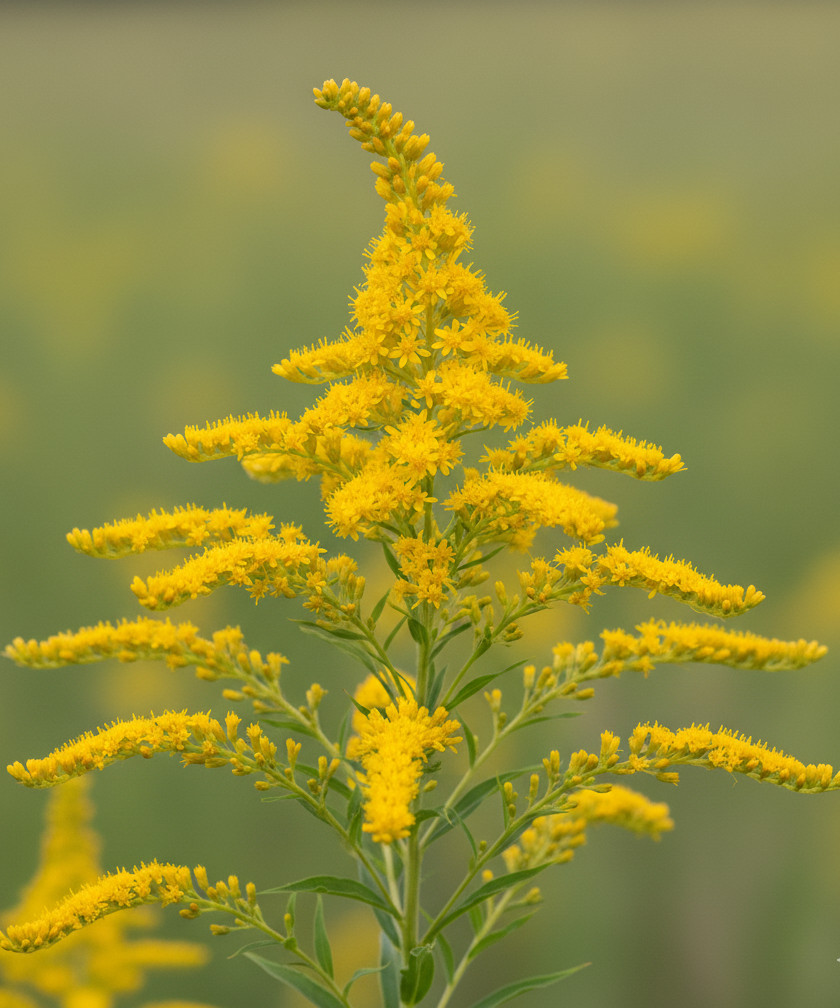
Making a Tincture
Tinctures typically involve alcohol but can be made with vegetable glycerin or vinegar if you do not consume alcohol. Keep in mind that when you are taking a tincture, you are taking such small amounts that it is impossible to feel any effects of alcohol.
I make a tincture by using 100 proof vodka. Fill a jar with fresh goldenrod. I like to cut it up into smaller pieces so I can fit more in and have more surface area for the alcohol to extract from. I feel it’s important that the plant be fresh, so it still retains all of its water and alcohol soluble properties. Make sure you fill the jar to the top with plant material, don’t pick a jar that’s larger than the amount of plant material you have. It doesn’t matter what jar you use, just make sure it has a lid that is tight.
When your jar is full of goldenrod, pour the alcohol over it until it reaches the brim of the jar. You may have to let it sit for a minute before the alcohol makes it into all the nooks and crannies. Add more if necessary. Seal the jar with the lid and sit it in a cool dark place for 6-8 weeks.
When it’s ready, strain out the plant material and your tincture is ready for use.
Tinctures are pretty powerful medicine, so start slowly when taking it. Start with just a few drops several times a day, and work up until you reach the number of drops your body needs to feel the health benefits of goldenrod.
Making an Oil Infusion
An oil infusion is best used to make a salve. My favorite oil to use is avocado oil, but you can use a pure olive oil, grapeseed oil, or basically any oil that isn’t soy or canola based. I wouldn’t recommend using either of those due to their inflammatory properties.
Oil infusions should be made with dry plant material only. Oil and water are the perfect breeding ground for bacteria. if you use fresh plant material your oil is going to end up growing mold.
Fill a jar up with dried goldenrod, use the stem and all. Just like with a tincture, cut the plant matter into smaller pieces to allow more surface area for extraction.
Pour the oil over the plant material up to the rim of the jar. Cap it tight and place it in a warm, dark place for 6 weeks. After 6 weeks, strain out the plant material and your oil is ready to go!
Pin it for later ⤵️
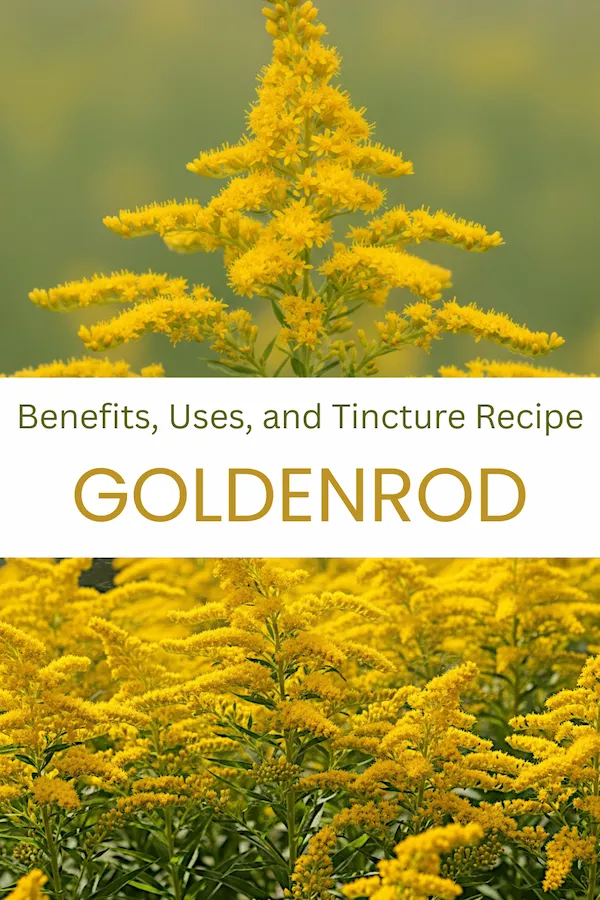
Sources:
Characterization and biological activity of Solidago canadensis complex
Antibacterial and antimutagenic activity of Solidago extracts
Insight into bioeconomy. Solidago canadensis as a valid resource. Brief review
Phytochemical and Pharmacological Research in Galenic Remedies of Solidago canadensis L. Herb




